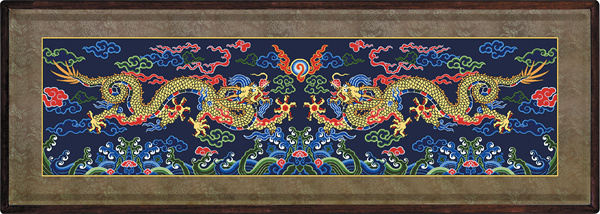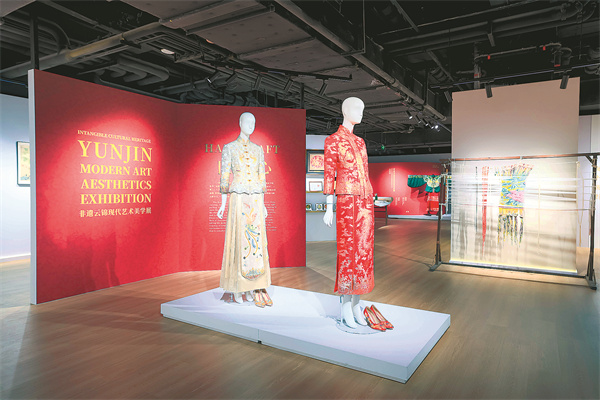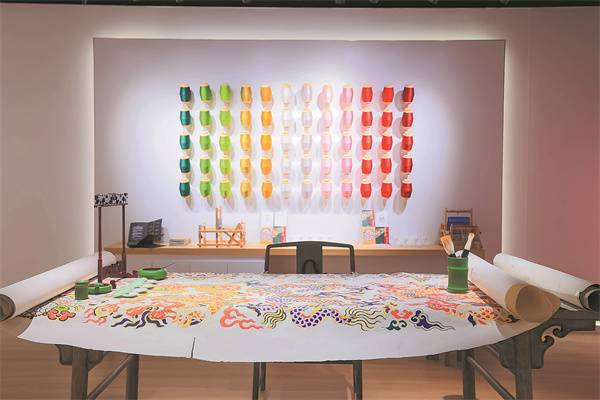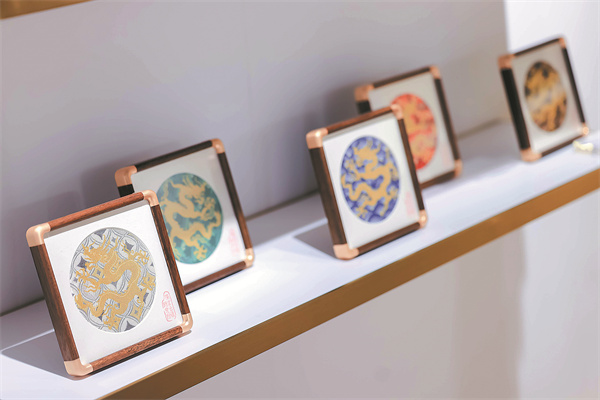Yunjin's scintillating silks
New exhibition in Shanghai spins the magic of the historical royal brocade tradition, Xu Haoyu reports.

A piece of brocade inspired by the emperor's court dress from the Kangxi era of the Qing Dynasty, featuring two golden dragons chasing a pearl in the sky. The bottom part shows the rising rivers, cliffs and sea, surrounded by clouds.[Photo provided to China Daily]
Brocade is often described in ancient Chinese texts as a kind of silk fabric that contains gold. Among the best-known Chinese brocades, Yunjin brocade from Nanjing, Jiangsu province, takes its name from its gorgeous, rosy cloudlike color.
This brocade is a high-end textile, distinguished by the incorporation of gold and silver thread and peacock feather filaments. Its intricate craftsmanship is such that a pair of skilled weavers collaborating over the span of a day are only able to produce 5 to 6 centimeters of the luxurious fabric, according to the Nanjing Yunjin Museum, which has successfully launched an exhibition in Shanghai's Jing'an district to showcase the long history and supreme craftsmanship of Yunjin brocade.
In 417, Nanjing set up a government institution specifically to manage brocade production, marking the birth of Yunjin brocade. During the Yuan (1271-1368), Ming (1368-1644), and Qing (1644-1911) dynasties, the technique reached its zenith. And due to its exquisite craftsmanship and artistic expression of gold weaving and color combining, Yunjin became both an imperial skill and fabric.

Modern Yunjin brocade formal wear showcases the application of the old technique in modern haute couture.[Photo provided to China Daily]
According to the museum, as early as in the Ming and Qing dynasties, the technique for weaving with gold thread had matured to the extent that one gram of gold could be hammered into gold foil 0.12 micrometers thick that could cover an area of 0.47 square meters.
Due to its extremely thin and lightweight nature, even skilled craftspeople have to control their breathing to avoid blowing the gold foil away. They flatten it on paper and cut it into the fine threads that eventually become the shimmering gold lines of Yunjin brocade.
After the founding of the People's Republic of China in 1949, the government paid special attention to the preservation and inheritance of brocade weaving techniques. In 1957, the Nanjing Yunjin Research Institute was founded, followed by the establishment of the Nanjing Yunjin Museum, the only museum in the country dedicated to the history, weaving techniques, culture and contemporary art related to this brocade style.

The Yunjin brocade weaving process demonstrated on-site.[Photo provided to China Daily]
In 2006, Yunjin was included in the first batch of national intangible cultural heritage forms in China. In 2009, it was inscribed on the Representative List of the Intangible Cultural Heritage of Humanity by UNESCO.
Having been passed down for 1,600 years, Yunjin brocade is a traditional treasure, as its cross-stitch and plain knitting express the freedom and skillfulness of human hands and to date, the traditional craft of making the same flower in different color patterns still cannot be done using modern machines.
The Shanghai exhibition, Intangible Cultural Heritage Yunjin Modern Art Aesthetics, is a comprehensive showcase of the process of craftsmanship and tools used in making Yunjin, as well as luxury garments, and art pieces that have been presented as State gifts to foreign leaders.
Additionally, the exhibition features the debut of several new Yunjin art pieces. To celebrate the upcoming Year of the Dragon, a decorative brocade painting named Long Rui Qian Qiu (Longevity of the Dragon), is on display.
In it, a dragon majestically raises its head, as auspicious clouds and flames are interspersed around it, with lingzhi (glossy ganoderma) mushrooms on either side symbolizing wealth, auspiciousness and longevity. The pattern of sea and cliffs at the bottom represents the blessings of fortune as solid as a mountain, longevity as broad as the sea and eternal peace. And the lantern pattern above enhances the festive holiday atmosphere, while also conveying hopes for a bountiful harvest, joy and celebration throughout the world.
Also on exhibition are the Yunjin Adorned Flower Auspicious Garment, a re-creation of a historical garment, and Cranes in Harmony, an artwork given as a State gift.
The displays allow visitors a closeup appreciation of Yunjin, and a more direct understanding of its intangible craftsmanship and aesthetic essence.
Wang Jian, vice-president of the Jiangsu Intangible Cultural Heritage Protection Association, says that the inheritance of Yunjin is the result of the efforts of many generations dedicated to its preservation.
"Seeing Yunjin leave Jiangsu for Shanghai is to witness its innovative transformation and creative development as part of the efforts of the Yunjin museum. This is a practical action to leverage Yunjin culture in facilitating the integrated development of the Yangtze River Delta region. We hope that this region will appreciate the beauty of Yunjin culture and develop even more closely together," Wang says.

The Yunjin pieces, inspired by the traditional Chinese "Soaring Dragon" pattern, symbolize "the dragon soaring into the sky, bringing fortune across the oceans".[Photo provided to China Daily]
Jian Mingwei, executive director of the China Arts and Crafts Society and director of the Nanjing Yunjin Museum, says that the choice to move the premiere of the exhibition from Nanjing to Shanghai is not just because Shanghai is a fashion capital of the East, but also because of the grand blueprint for the integrated development of the Yangtze River Delta. He expresses the hope that Yunjin culture will aid in the integration and development of the region.
Discussing the reasons behind curating the exhibition, Zu Hao, the director of the museum's publicity department, says that art should evolve with the times, and craftsmanship should lead fashion.
"By integrating with contemporary art, Yunjin has long been a benchmark of Chinese aesthetics. In modern times, it is even more essential to invigorate its vitality through innovation to continue the excellent core of traditional Chinese culture with orthodox methods and to showcase national cultural confidence," Zu says.
Li Min, one of the visitors to the exhibition, says: "Through this exhibition, I learned for the first time that no matter how complex the patterns are, Yunjin always feels flat to the touch, and because ostrich and peacock feathers are incorporated into the silk weaving, the details of Yunjin are always so varied and intricate."
Tian Zhi, a 24-year-old visitor, was amazed by the colors she saw. "The Yunjin silk threads are so beautiful. I really want to dye my hair these colors," she says with excitement.
The show continues until May 11, during which time the exhibits will be periodically updated.